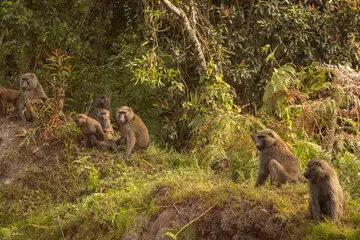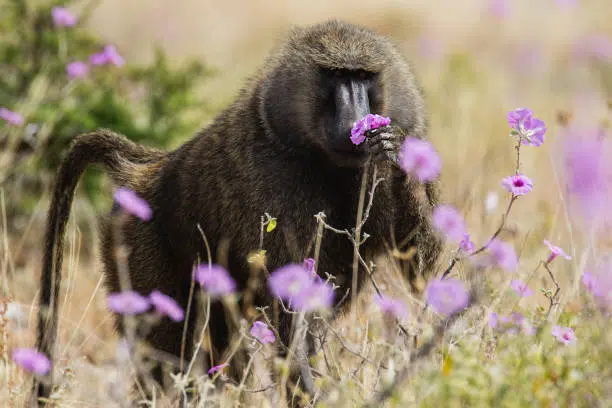Table of Contents
Scientific Classification
| Kingdom | Animalia |
| Phylum | Chordata |
| Class | Mammalia |
| Order | Primates |
| Family | Cercopithecidae |
| Genus | Papio |
| Species | P. anubis |
| Scientific Name | Papio anubis |
Description
The Olive Baboon (Papio anubis) stands out as one of the most prevalent and adaptable baboons across Africa. With a coat that resembles the greenish-grey hues of olive trees, this primate embodies a fascinating blend of strength, intelligence, and social prowess. Adult males are particularly robust, often towering over females, and can tip the scales at around 50 kilograms (110 pounds). Their sturdy physique is complemented by a distinctive mane that frames their heads and shoulders.
Their hairless faces are dark and expressive, featuring a long muzzle and sharp canines that add to their character. Those thoughtful eyes reveal a depth of intelligence and a range of complex emotions. With powerful limbs, they excel at both running swiftly and climbing adeptly, showcasing their ability to thrive both on the ground and in the trees.
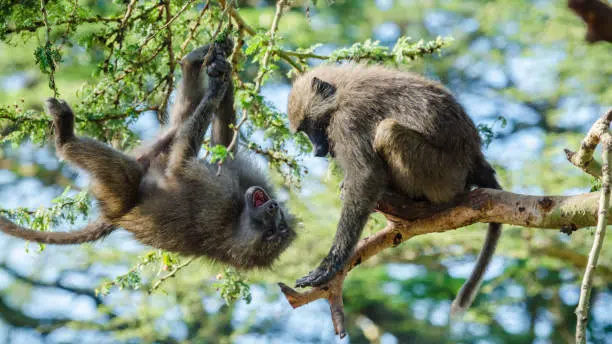
Distribution
The Olive Baboon has one of the widest ranges of any non-human primate, making it quite remarkable. You can find them across 25 countries in Africa, stretching from Mali and Guinea in the west all the way to Ethiopia and Sudan in the east. They even make their home in the northern regions of Zambia and Tanzania down south.
This broad distribution highlights their incredible ability to adapt to various climates and landscapes. Unlike many other primates, Olive Baboons thrive in a variety of environments, often living close to human communities.
Habitat
Olive Baboons thrive in a variety of habitats, including savannas, woodlands, and the edges of forests. You can also find them in mountainous regions, semi-arid plains, and occasionally on farms. They prefer areas with plenty of open space for foraging, but they also need trees or rocky outcrops to sleep and find safety.
Water plays a vital role in where they choose to live. Typically, these troops like to stay close to a reliable water source. During the dry season, they might even dig in sandy riverbeds to access underground water supplies.
Diet
The Olive Baboon is truly the king of adaptability when it comes to food. Their diet is impressively varied, changing with what’s available:
They primarily munch on fruits, seeds, and leaves.
With their nimble fingers, they dig up roots and tubers.
They also snack on insects, small mammals, birds, and even other primates, showcasing their meat-eating side.
In areas where humans live, they’ve gained a reputation for raiding farms and stealing crops.
This ability to eat a wide range of foods allows them to thrive, even in challenging or fragmented environments.
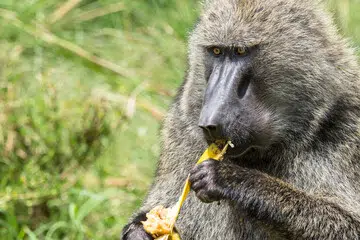
Behavior
Olive Baboons have fascinating social structures. They often gather in troops that can range from 15 to over 150 members. Within these troops, there’s a clear hierarchy, with males fiercely vying for the top positions, while females typically inherit their rank from their mothers.
Social interactions play a crucial role in their lives. Grooming, for instance, isn’t just about hygiene; it’s a way to build alliances, ease tensions, and strengthen relationships. While disputes do arise, they’re usually settled through vocalizations, posturing, and minimal aggression.
Their communication is quite rich and includes:
– Grunts for reassurance,
– Barks that serve as alarm calls,
– Screams during conflicts,
– And subtle facial expressions that convey their emotional states.
Though Olive Baboons can show aggression at times, they also form strong emotional connections, particularly between mothers and their infants, as well as within family groups.

Lifespan
In the wild, Olive Baboons typically live around 25 to 30 years. But when they’re in captivity, with proper veterinary care and plenty of food, they can thrive for over 40 years!
Unfortunately, infant mortality rates are quite high due to threats from predators and diseases. However, once they move past the juvenile stage, their chances of reaching adulthood significantly improve.
Reproduction and Lifecycle
Olive Baboons breed all year. Females can get pregnant at any time. Reproduction is deeply influenced by social dynamics.
Key Reproductive Milestones:
- Gestation Period: About 6 months.
- Litter Size: Usually 1 infant.
- Nursing Period: Around 6 months to 1 year, with ongoing maternal care afterward.
- Sexual Maturity: Females reach maturity around 4–5 years, males around 6–7 years.
Mothers are very protective. Infants hold on closely to their bellies in the first weeks. As they grow, they ride on their mom’s back. They also interact more with other troop members.
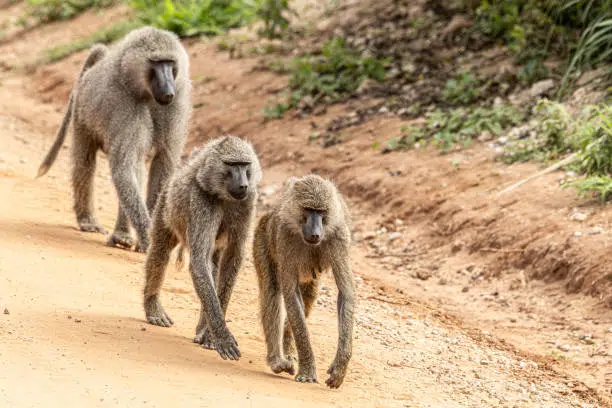
Predators
Olive Baboons are strong and have sharp teeth, but they still face many predators:
- Lions, leopards, and hyenas are their chief terrestrial threats.
- Crowned eagles target juveniles.
- Humans, both through hunting and conflict, represent a significant modern danger.
To stay safe from threats, baboons sleep high up in trees or on cliffs. They also have sentries that alert the troop about nearby predators.
Adaptations
The Olive Baboon’s success can be attributed to several remarkable adaptations:
Physical Adaptations:
- Strong limbs for climbing and running.
- Sharp canines for defense and competition.
- Thick fur for temperature regulation.
Behavioral Adaptations:
- Flexible diet allows them to survive environmental changes.
- Social structure provides safety in numbers.
- Tool use and intelligence help them manipulate their environment and outsmart predators.
They have even been observed using stones to crack open nuts or to threaten predators and rivals.
Mating Season
These creatures can mate throughout the year, but you’ll notice a real uptick in activity when food is abundant, especially during the wet season. Males tend to get more competitive during this period. Meanwhile, females display noticeable swellings that signal they’re ovulating and ready to mate.
The dynamics between males and females can sometimes feel transactional. Males often groom females in hopes of securing mating opportunities. However, genuine friendships can blossom too, particularly between a female and a protective male. This special connection is often referred to as a “consort partner.”
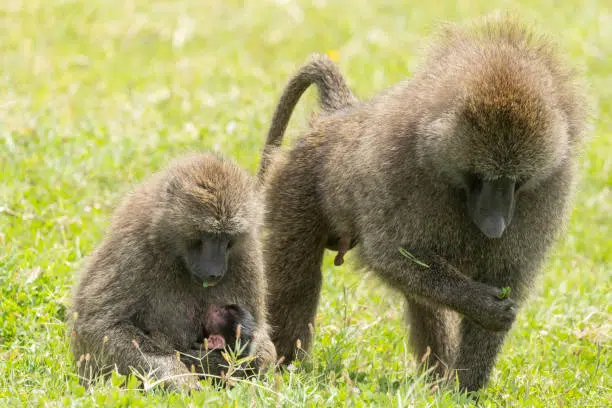
Breeding
Once conception happens, the female goes through a gestation period of around 180 days. Births usually occur at night or in hidden spots. The infants are born with black fur and pink faces, which makes it easier for the group to spot and protect their youngest members.
Male baboons are becoming more involved in caring for the infants, particularly those that are higher in rank. They might carry, groom, or keep an eye on the little ones. These behaviors not only help the males increase their chances of mating but also reduce the risk of infanticide.
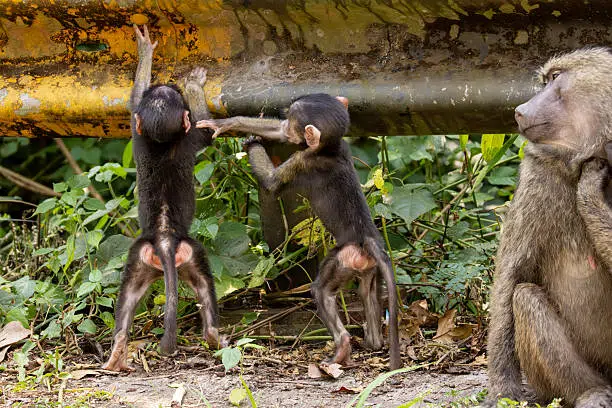
Interesting Facts
- Named After a God: The name “anubis” for this species is inspired by the Egyptian god Anubis, who is often depicted with a canine face resembling that of a baboon.
- Political Minds: Olive Baboons are quite the social strategists! They form groups, build alliances, and even navigate complex social dynamics—skills that are pretty rare in the animal kingdom.
- Hybrid Zones: These baboons don’t just stick to their own kind; they also interbreed with other baboon species, especially where their territories overlap with yellow baboons and hamadryas baboons.
- Emotional Intelligence: Olive Baboons show a deep emotional side, mourning their fallen troop members and interacting gently with one another during tough times.
- Fear of Snakes: Like many primates, Olive Baboons have a strong reaction to snakes. They might act like they’re going to attack or, alternatively, back off cautiously when they spot one.
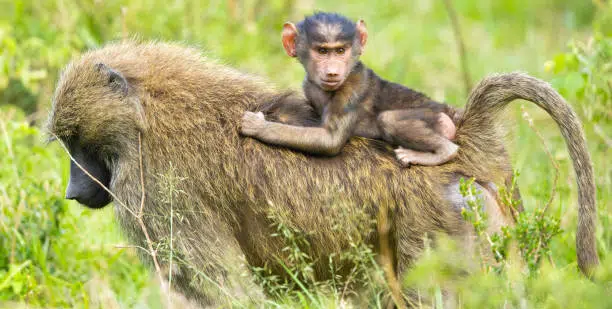
Conservation Status
The IUCN calls the Olive Baboon “Least Concern.”” This means they are widespread and adaptable.
However, they are increasingly impacted by:
- Habitat loss due to agriculture and urban expansion,
- Hunting for bushmeat or in retaliation for crop-raiding,
- And disease transmission in areas with human-wildlife interaction.
Despite these threats, their populations remain stable in most regions.
Conservation efforts have three main goals:
- Reducing conflict
- Managing protected areas
- Educating the public
This helps promote coexistence.
Conclusion
The Olive Baboon is so much more than just another primate. It offers us a fascinating glimpse into the intricate evolution of social animals. These creatures are incredibly intelligent, much like many other mammals. Their behaviors often echo the complexities of human politics, blurring the lines between the wild and the familiar. They’ve adapted to thrive in a variety of environments, from arid savannas to lush forests, showcasing their resilience and creativity along the way.
Caring for the Olive Baboon goes beyond merely saving a species; it’s about safeguarding a unique chapter in the story of life on Earth.
